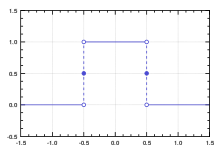Hàm rect

Hàm chữ nhật hay hàm rect là một hàm toán học liên tục được định nghĩa như sau:[1]
Ngoài ra, trong nhiều lĩnh vực đặc biệt là lĩnh vực xử lý tín hiệu, hàm rect còn được định nghĩa theo cách khác như sau:[2]
Biến đổi Fourier
[sửa | sửa mã nguồn]Biến đổi Fourier liên tục của hàm rect là một hàm sinc:
và:
Mối quan hệ với hàm tri
[sửa | sửa mã nguồn]Tích chập của 2 hàm rect là 1 hàm tri.
Ứng dụng trong xác suất
[sửa | sửa mã nguồn]Sử dụng hàm rect như là một hàm mật độ xác suất, nó là 1 trường hợp đặc biệt của phân phối đều liên tục với .
với là một hàm hypebolic.
Biểu diễn bằng hàm hữu tỉ
[sửa | sửa mã nguồn]Hàm rect có thể được biểu diễn dưới dạng là giới hạn của 1 hàm hữu tỉ:
Chứng minh
[sửa | sửa mã nguồn]- Trường hợp . Với mọi số nguyên
nthì(2t)2nluôn luôn dương. Do2t<1cho nên(2t)2n→0khin→∝.
- Suy ra:
- Trường hợp . Với mọi số nguyên
nthì(2t)2nluôn luôn dương. Do2t>1cho nên(2t)2n→∝khin→∝.
- Suy ra:
- Trường hợp .
- Dễ dàng ta có:
Từ đó có thể định nghĩa hàm rect như sau:
Chú thích
[sửa | sửa mã nguồn]- ^ Weisstein, Eric W. (ngày 15 tháng 8 năm 2011). "Rectangle Function". Wolfram MathWorld. Wolfram. Truy cập ngày 15 tháng 8 năm 2011.
- ^ (tiếng Đức)Signalübertragung (ấn bản thứ 6.). Springer Verlag. 1995. tr. 2. ISBN 3-540-54824-6.
{{Chú thích sách}}:|first=thiếu|last=(trợ giúp)
Chúng tôi bán
 GIẢM
24%
GIẢM
24%
35.000 ₫
46.000 ₫
 GIẢM
17%
GIẢM
17%
100.000 ₫
120.000 ₫
 GIẢM
30%
GIẢM
30%
699.000 ₫
999.000 ₫
![[Review Sách] Quân Vương](https://down-bs-vn.img.susercontent.com/vn-11134207-7ras8-m3xseo54r38h50.webp) GIẢM
32%
GIẢM
32%
46.512 ₫
68.000 ₫
 GIẢM
18%
GIẢM
18%
115.000 ₫
140.000 ₫
 GIẢM
18%
GIẢM
18%
45.000 ₫
55.000 ₫
![{\displaystyle \operatorname {rect} (t)=\sqcap (t)={\begin{cases}0&{\text{khi }}|t|>{\frac {1}{2}}\\[3pt]{\frac {1}{2}}&{\mbox{khi }}|t|={\frac {1}{2}}\\[3pt]1&{\text{khi }}|t|<{\frac {1}{2}}.\end{cases}}}](https://wikimedia.org/api/rest_v1/media/math/render/svg/5b6c1883f64d8b1640bcc507361b7c523678cdb9)
![{\displaystyle \operatorname {rect_{d}} (t)={\begin{cases}1&{\text{khi }}|t|\leq {\frac {1}{2}}\\[3pt]0&{\text{khi }}|t|>{\frac {1}{2}}.\end{cases}}}](https://wikimedia.org/api/rest_v1/media/math/render/svg/31385cf51ff4238196a62d9d62d0ded24d1dfefb)


















